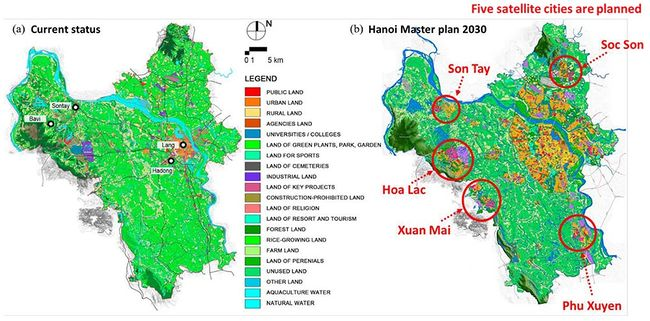OR/18/068 Urban development in Hanoi
| Bide, T P, Brown, T J, Petavratzi, E, and Mankelow, J M. 2018. Vietnam – Hanoi city material flows. Nottingham, UK, British geological Survey. (OR/18/068). |
Hanoi is located in the northern Vietnam, in the Red River delta, approximately 90km from the coast. In recent decades Hanoi has undergone significant transformation and rapid expansion has led to the achievement of the international metropolitan status (Leducq and Scarwell, 2018[1]), as well as this a change in the official city boundary in 2008 has substantially increased the size of the city. Since the Doi Moi policy (1986), increased globalisation and the significant development observed in neighbouring countries in South East Asia has meant that Hanoi has entered a new era of expansion with plans in place to increase the metropolitan area to 3300 km2. The Hanoi planning strategy is described in the Hanoi Master Plan 2030–2050 document. The urban plan follows similar trends observed in many cities worldwide and is based on an urban cluster model adopted by many Asian cities (Leducq and Scarwell, 2018[1]). In brief, the plan includes the following (JICA and Hanoi People's Committee, 2007; Leducq and Scarwell, 2018[1]; Trihamdani et al., 2017[2]):
- An urban core, extended to include additional neighbouring provinces.
- Five satellite cities with a population range between 130 000 to 600 000 inhabitants. These include the Hoa Lac (science and technology urban centre), Son Tay (focus on culture and tourism), Soc Son (focus on industry and tourism), Xuan Mai, Phu Xuyen.
- Three eco township/villages that include Phuc Tho, Quoc Oai and Chuc Son.
- An extensive urban network system consisting of highways, express ways and park ways, plus an urban railway network (high speed railway and metro) that connects all major development areas between them and with the urban core, and which also provides connections with the rest of the country.
- A green belt to serve the purpose of environmental and agricultural conservation. This is going to be developed on the west of the current urban core.
- A blue corridor with flood management areas.
- An upgrade of existing urban areas to improve living standards, preserve the cultural heritage and promote economic growth.

Several challenges have been identified by previous research regarding the urban expansion plans in Hanoi. These are important and may obstruct future development in Hanoi. They include (JICA and Hanoi People's Committee, 2007[3]; Leducq and Scarwell, 2018[1]):
- Impacts to water management: installation of formal drainage networks is not keeping pace with urban expansion to the urbanisation growth and the risks for flooding are therefore higher. In addition existing issues associated with clogged irrigation channels and unequal access to irrigation for agriculture add to the impact.
- Governance issues due to the extended size of the Hanoi territory. Several stakeholders and multi-party planning policies are involved, including an increasing number of private companies who are responsible for managing urban development projects in Hanoi.
- Transport issues associated with traffic and road congestion are increasing. These are attributed to urban growth, which pose pressures on transport infrastructure and have led to the development of a new ‘Transport plan to 2030, with a vision to 2050’. The Transport Plan gives priority to public transport and it includes a new highway network and a new metro with an urban rail of 8 lines and a total length of about 318 km.
- Hanoi is experiencing a construction boom in order to accommodate the continuously increasing urban population. A shift to the development of high-rise buildings is already apparent with around 20 skyscrapers already in place and more than 10 currently under construction. In addition, more than 700 real estate projects have been given permits, often comprising semi-detached or detached houses that do not resemble the style of old apartments and the typical three to five storey tube houses. Meeting the demand for material required to support the construction work taking place is challenging and if not managed well may lead to negative impacts on the environment, affect social cohesion, limit economic development and increase the potential for supply disruption.
- Land use issues and pressures on agricultural land. These originate from the transformation of land from agricultural to urban use, the rate of transformation and the way that this takes place.
- Concerns over the metropolitan land use plans that may be compromised by the growing urban economy.
- Changes in the social dimension of Hanoi’s metabolism associated with the demographic transformation, the land use changes, cultural changes associated with urbanisation, and the development of new technology and industry hubs to support economic growth. These will require access to more resources (e.g. material, water, energy, food) and management of the social (e.g. living standard expectations) and environmental aspects (e.g. waste and water management, air pollution) of the urban transformation.
References
- ↑ 1.0 1.1 1.2 1.3 LEDUCQ, D, and SCARWELL, H-J. 2018. The new Hanoi: Opportunities and challenges for future urban development. Cities, Vol. 72, 70–81.
- ↑ 2.0 2.1 TRIHAMDANI, A R, KUBOTA, T, LEE, H S, SUMIDA, K, and PHUONG, T T T. 2017. Impacts of Land use Changes on Urban Heat Islands in Hanoi, Vietnam: Scenario Analysis. Procedia Engineering, Vol. 198, 525–529. https://www.sciencedirect.com/science/article/pii/S1877705817329533
- ↑ JICA, and HANOI PEOPLE'S COMMITTEE. 2007. The Comprehensive Urban Development programme in Hanoi Capital City of the Socialist Republic of Vietnam (HAIDEP). Japan International Cooperation Agency (JICA)